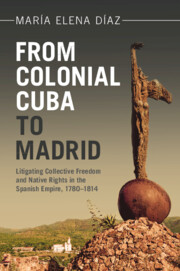 From Colonial Cuba to Madrid
From Colonial Cuba to Madrid Book contents
- From Colonial Cuba to Madrid
- Afro-Latin America
- From Colonial Cuba to Madrid
- Copyright page
- Contents
- Figures and Tables
- Acknowledgments
- Introduction
- 1 Imperial Reform, Privatization, and Enslavement
- 2 An Unorthodox Pueblo and Its Apoderados
- 3 Making the Case for Collective Freedom
- 4 Native Bonds, Native Rights
- 5 The Council’s Ruling and the Politics of Litigation
- 6 A “Pernicious” Communication
- 7 Violence, Marronage, and Litigation
- 8 The Final Outcome of the Case
- 9 The Nineteenth-Century Afterlife of the Freedom Edict of 1800
- Conclusion
- References
- Index
9 - The Nineteenth-Century Afterlife of the Freedom Edict of 1800
Published online by Cambridge University Press: 14 November 2024
- From Colonial Cuba to Madrid
- Afro-Latin America
- From Colonial Cuba to Madrid
- Copyright page
- Contents
- Figures and Tables
- Acknowledgments
- Introduction
- 1 Imperial Reform, Privatization, and Enslavement
- 2 An Unorthodox Pueblo and Its Apoderados
- 3 Making the Case for Collective Freedom
- 4 Native Bonds, Native Rights
- 5 The Council’s Ruling and the Politics of Litigation
- 6 A “Pernicious” Communication
- 7 Violence, Marronage, and Litigation
- 8 The Final Outcome of the Case
- 9 The Nineteenth-Century Afterlife of the Freedom Edict of 1800
- Conclusion
- References
- Index
Summary
Focusing on the afterlife of the Freedom Edict of April 7, 1800, the chapter moves the story into the nineteenth century, a period of imperial crisis that saw the emergence of liberal trends in the empire as well as new stakeholders in the historical context of the island and, more generally, of the Spanish Atlantic world. Chapter 9 focuses on the problems that the emancipated cobreros faced in actualizing a corporate community model along the lines of colonial Indian law. It further compares El Cobre’s predicament in the new period with that of two other recognized Indian pueblos of El Caney and Jiguani, a situation that resonated elsewhere in the Spanish Atlantic in the postcolonial Latin American republics. Questions about native rights, race, and citizenship, about civil and political rights, about corporate and individual land rights emerged in this new political context, especially with the globalization of El Cobre. This globalization was linked to the arrival of French refugees and the development of a British mining industry in the region. These emerging trends led to the erasure of major aspects of the Freedom Edict of 1800 by the early 1840s.
Keywords
- Type
- Chapter
- Information
- From Colonial Cuba to MadridLitigating Collective Freedom and Native Rights in the Spanish Empire, 1780–1814, pp. 285 - 310Publisher: Cambridge University PressPrint publication year: 2024
